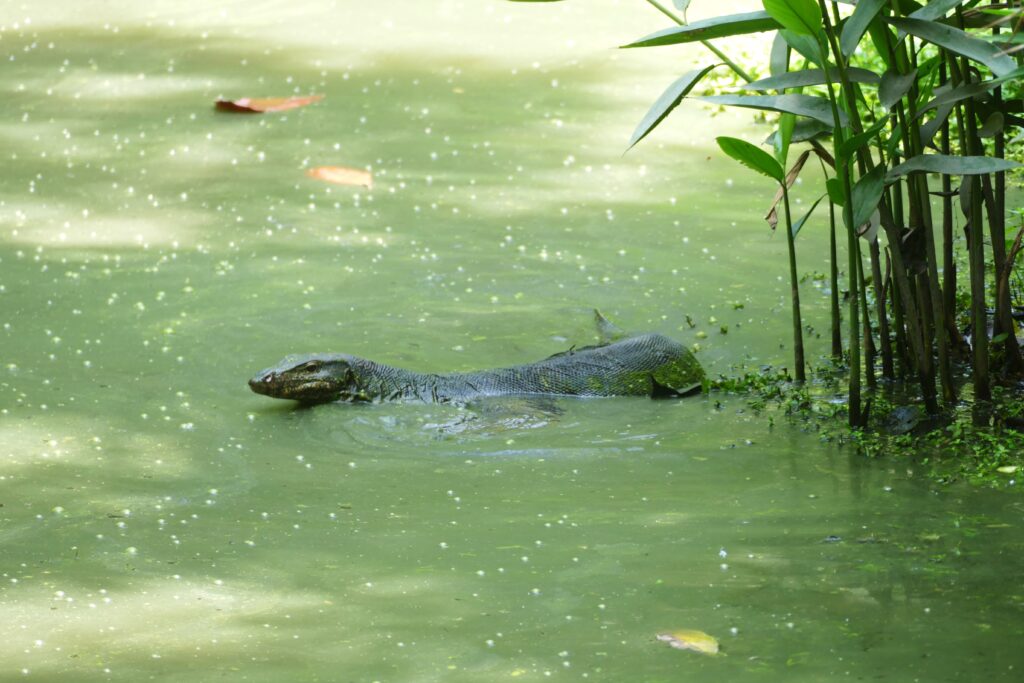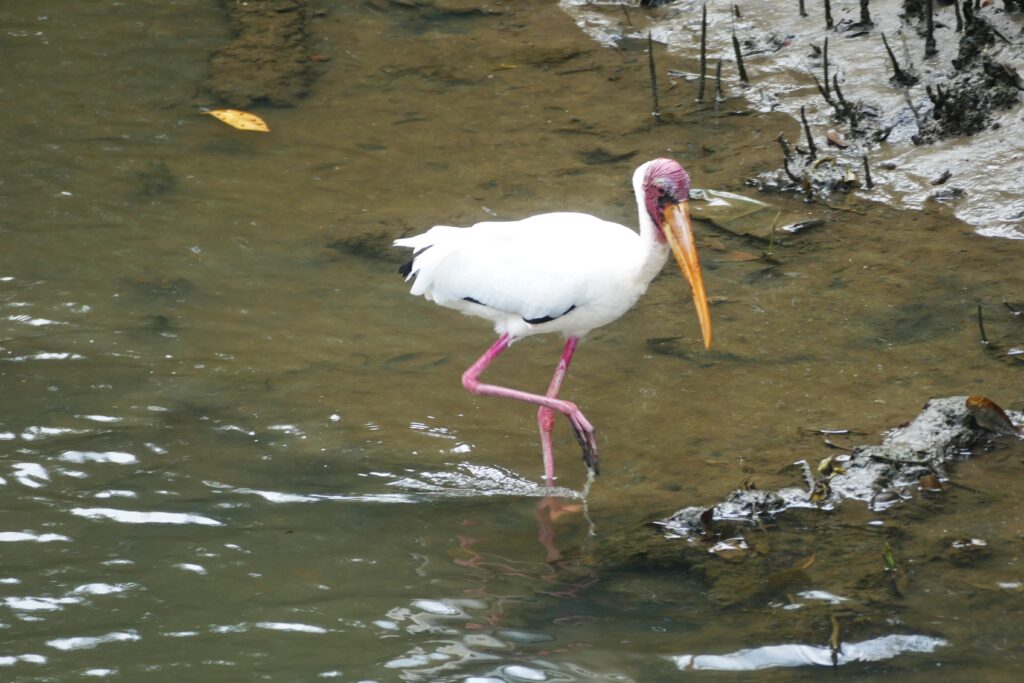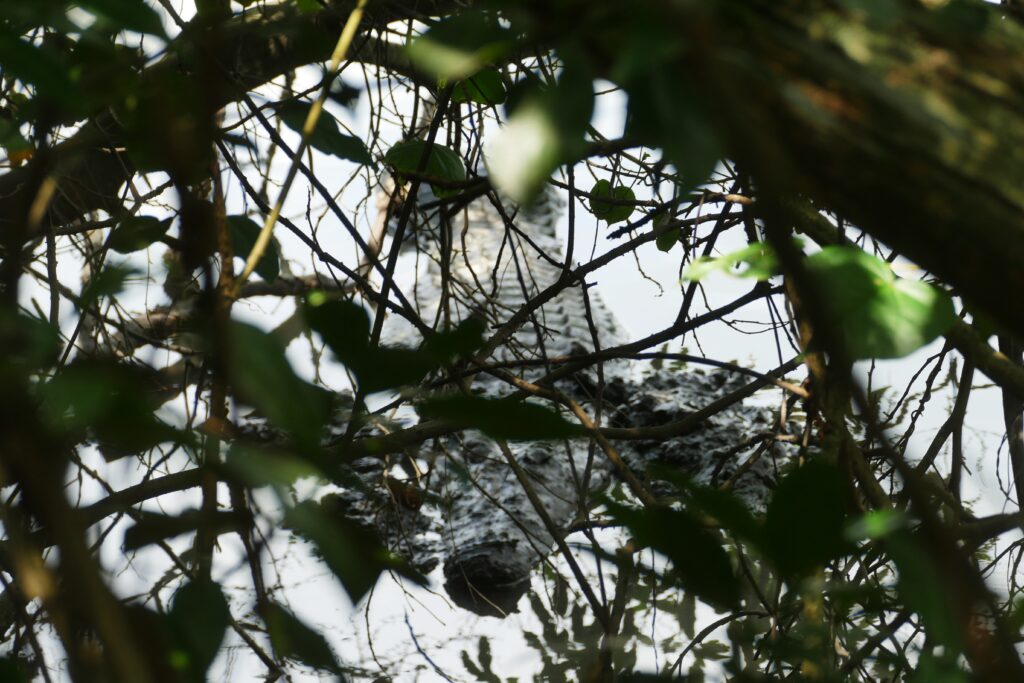“What does it really mean to have a good quality of life? Singaporeans are starting to think about this question, and the conclusion they draw often leads them outdoors,” Dr Sng Bee Bee, member of the Nature Society Singapore, contemplates as we explore Sungei Buloh, Singapore’s first designated wetland reserve, together.
Singapore, a small tropical island nation, has the third highest population density of any country in the world. Many of its natural habitats have been heavily impacted since the 1800s, when more than 90% of the island’s primeval forests were transformed into gambir and pepper plantations and later into plantations for rubber and other agricultural products. About 95% of its original mangrove forests and 60% of its coral reefs have also disappeared due to foreshore reclamation and damming of major rivers to create freshwater reservoirs.
After gaining independence in 1965, Singapore started embarking on greening initiatives and innovative urban planning programmes, making strides in protecting its natural areas as well on the path to transform the country into a global, forward-looking metropolis. Despite its limited land area of just over 730 km², this city-state still has pockets of forests that provide a home to over 50 native mammal species, including the world’s most trafficked animal, the Sunda pangolin. Some of its remaining few mangrove forests recently began to welcome back the Saltwater crocodiles, one of the largest crocodile species in the world, and the playful native smooth-coated otter population has also been recovering since the 1990s. An incredible biodiversity right at people’s doorstep.
As we arrive in Singapore, the final destination of our transnational cycling journey, we realise what is at the core of the city-state’s success and its international recognition in protecting its rich biodiversity: its active and involved citizens. We came to learn about one grassroots yet formidable organisation dedicated to the preservation of Singapore’s natural heritage, the Nature Society, Singapore (NSS).
A rich history of nature-admiration and advocacy
Established in 1954 as the Singapore branch of the Malayan Nature Society (MNS) before it became the Nature Society, Singapore, in 1991, this organisation has been a steadfast advocate for environmental conservation, biodiversity protection, and sustainable development, leaving an indelible mark on the landscape and the community. “We have about 1300 members right now, who are comprised of ordinary citizens, as well as experts, like amateur naturalists, professional biologists, businessmen, politicians, government employees, so everyone, let it be Singaporean or expatriate, is interested in protecting Singapore’s biodiversity,” Bee tells us. “We are all volunteers; the organisation is volunteer-based, with only two full-time staff.”
The origins of the MNS go all the way back to the 1940s, when it was dominated by expatriate British colonials and scientists who wanted to enjoy the wonders of nature. But today, about 80% of the NSS members are local-born Singaporeans, who have been noticing that the rapid urban development, population growth, and climate change are encroaching upon precious green spaces and disrupting Singapore’s fragile and already fragmented ecosystems.
From its humble beginnings as a small group of nature enthusiasts, NSS has grown into a prominent voice for conservation in Singapore. Over the last 50 years, the Society has spearheaded numerous campaigns, initiatives, and policy interventions aimed at safeguarding the country’s precious natural resources. Whether advocating for the protection of wildlife habitats, challenging unsustainable development projects, or promoting environmental education, the growing member base of NSS has remained unwavering in its commitment to preserving Singapore’s biodiversity for future generations.
The story of Sungei Buloh and Singapore’s development
“Let me tell you about this place, because it is one of our biggest successes,” Bee greets us at the Kranji MRT train station, from where we head towards Sungei Buloh Wetland Reserve. “Previously totally unheard of as a significant nature area, in 1988, NSS came forward with a proposal to designate Sungei Buloh as a protected area,” Bee recalls. “NSS members recorded an unusually high variety of bird species, including migratory birds from as far as Siberia and Mongolia, who made a stopover here on their way to Australia. At the end, the government was persuaded to declare Sungei Buloh a mangrove and bird sanctuary and bring it under legal protection. This site is now known as Sungei Buloh Wetlands Reserve.”



Learning about Singapore’s wild corners with Dr Sng Bee Bee and Jimmy Tan San Tek from the Nature Society Singapore.
Jimmy Tan San Tek, a member of NSS Facebook group and dedicated environmental advocate, soon catches up with us. He started being involved in activism during the Covid pandemic in 2020, when, as he recalls, there was a momentum for nature protection causes in Singapore. Alongside his involvement in NSS activities, Jimmy has been observing land use changes in Singapore, since he worked as a Geography editor in educational publishing for about 20 years. He noticed the destruction happening to Tengah Forest, a biodiverse forest in midwest Singapore, which is set out to be transformed into “Tengah Forest Town ”. According to the development plan, this town is supposed to be a sustainable, green and forest-themed residential area. However, Jimmy started a petition together with two other nature advocates to call for a significant reduction of its impacts, as its construction is causing widespread destruction of an extensive secondary rainforest, while not offering enough space and ecological connectivity for wildlife (such as critically endangered Sunda pangolins, leopard cats and straw-headed bulbuls) to move between the western water catchment and central nature reserves. The petition has been signed by over 10,000 residents.
“Secondary forests are often just classified as wasteland or swamps, but in fact, they are often home to many endangered or rare species. In the case of Tengah Forest, prioritising human profits by developing homes will demolish the natural habitats of our wildlife,” explains Jimmy, who took the initiative to study the impacts of deforestation as he lives and works in the neighbourhood as a resident of Bukit Batok. “Cutting down forests but saying there will be ‘eco-development’ is absurd.”
Jimmy raises an important question. In our quest to create greener and more sustainable cities, where is the line between nature protection and green spectacularisation? “Nature to the government is a cultivated garden. But in reality, nature is what is left alone,” adds Bee.



Our journey into this beautiful mangrove reserve was also recounted in a great write-up by Jimmy in celebration of the 30th anniversary of Sungei Buloh Wetland Reserve.
While we talk and walk along the boardwalks in Sungei Buloh, we see plantain squirrels scurrying among the trees. We also observe purple herons, great-billed herons and painted storks feeding in the shallow water, while huge Malayan water monitor lizards pass us in each corner. We even manage to spot ‘Tailless’, a famous saltwater crocodile that lost its tail hiding in the mangroves. As we observe such rich biodiversity inside the city-state, we feel thankful that Sungei Buloh has been protected, and not destroyed in the name of “green development”.






Green crested lizard, signs of Common palm civet, countless Malayan water monitor lizards, Milky storks, and an infamous Saltwater crocodile were only some of the observations we made in Sungei Buloh.
“Due to massive construction works destroying mangrove forests across the border in Malaysia in Johor Bahru, crocodiles, otters, and wild boars came over to Singapore. Birds stop on their long migration route in this urban city, and rest in key wetland areas. It is our duty to protect them,” Bee adds.
The Green Rail Corridor: a joint success
Thanks to its conservation projects and surveys, NSS managed to bring several nature areas in Singapore under protection. NSS has a deep commitment to scientific research and evidence-based conservation practices. The society has separate expert research groups for birds, marine conservation, insects, vertebrates and plants. Dedicated volunteers and experts regularly conduct field studies, surveys, and monitoring programmes to assess the health of ecosystems, track changes in biodiversity, and identify areas inside Singapore that should have conservation priority. All this data collection and analysis that NSS members do on a voluntary basis provide invaluable insights into the state of Singapore’s natural environment, informing conservation strategies and guiding decision-making processes, especially when it comes to development.
Since its independence, Singapore has continually worked on creating its image as a ‘Garden City’, ‘City in a Garden’, or the latest ‘City in Nature’. It is no wonder that the country’s greening projects have progressively been interpreted globally as a symbol of wealth, stability, and discipline. At the same time, given its geographical location near the Equator which experiences hot, wet and humid weather all year round, Singapore’s vulnerability to the impacts of climate change has also forced the government to adopt innovative ideas when creating new urban environments.
When in 2011 the Malaysia and Singapore Governments agreed that the old railway line cutting through Singapore would be returned to Singapore, the local nature enthusiasts immediately stepped forward. It was a joint process between the Singapore Government, the National Parks Board (NParks), NSS, Residents’ Committees and Heritage Groups to create something special with this passage. Thanks to rigorous biodiversity surveys, lobbying and consultations between different working groups, the 24-kilometre-long Green Rail Corridor is now a green corridor that cuts across Singapore and connects several nature parks, providing habitat connectivity for the country’s wildlife.
Empowering the community through education
Education and outreach are also fundamental pillars of NSS’s conservation mission. The society organises a wide range of educational programmes, workshops, and public events aimed at raising awareness about environmental issues and inspiring action. Through guided nature walks, wildlife watching, talks, exhibitions, school outreach activities and volunteer activities such as coastal cleanups, NSS engages people of all ages and backgrounds, instilling a sense of appreciation for Singapore’s natural heritage and empowering individuals to become stewards of the environment.



Cultivating awareness about Singapore’s natural wealth – this is the ultimate goal of the nature education activities of the Nature Society, Singapore.
Even when it comes to decision-makers, NSS finds a simple but effective way to reach them. “In these positions, many people are disconnected from what’s happening at the ground level. At NSS, we take ministers out on nature walks, show them the beauty of the natural environment, and give them a short taste into the natural heritage that remains to be protected,” Bee explains.
In one of their current citizen science projects called ‘Every Singaporean a Naturalist’, NSS aims to bring young Singaporeans closer to nature. They achieve this by teaching them about local flora and fauna as well as by equipping them with the skills and knowledge needed to understand the intricate connections in an ecosystem. As we say goodbye at the end of our nature exploration trip, Bee shares a word of wisdom that is probably the strongest foundation of all.
“How we get children to care for the environment is by teaching them empathy. In our current education system, we learn how to graduate with good grades and how to get a decent job, but we do not learn to have empathy. Empathy is what we need to live in harmony with nature.”

